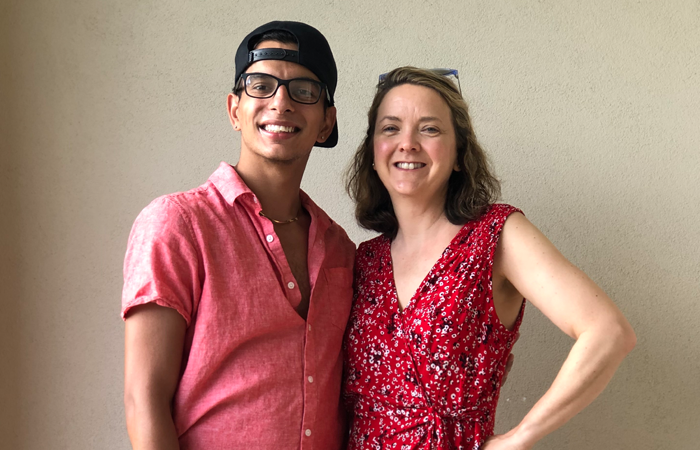I vividly recall my dawning awareness that my 11-year-old daughter was changing. We were at my nephew’s Bar Mitzvah celebration, and she was upset and angry with me because her dress was “so much longer!” than all the 13-year-old girls’ dresses at the party. She’d worn the same dress to a Bat Mitzvah just six months earlier and had been fine.
To many parents, the change seems sudden and shocking: Your friendly, chatty youngster has become a bit churlish. You get one-word answers to your questions—often accompanied by sighing and eye rolling. You knew that teenagers’ behavior could be challenging as they work through the developmental task of separating from parents and seeking greater independence in preparation for adulthood, but your child’s just a preteen; you thought you had more time! What’s more, that eye-roller may ask to cuddle with you hours later. Welcome to pre-adolescence.
What’s on a Preteen’s Mind?
Preteens are going through puberty, and the impact of these hormonal changes on their physical, psychological, cognitive, emotional, and social development is enormous. It’s not just their bodies that are changing, but their brains. While there will still be times you recognize your long-familiar children, preteens are becoming more self-conscious. They are increasingly aware of the world outside their family. They are beginning to dip their toes into the world of adolescence, which means they start wanting more distance from their parents. Friends become increasingly important. Preteens also become very interested in what teens are doing, and may closely observe their older siblings and other teens—at school, summer camp, athletic events, and social gatherings, as well as in books, movies, television shows, and on social media.
Because they are beginning the process of separating, preteens may begin to communicate less with their parents. This is challenging for all parents, and confusing, because our children never truly stop needing us to be a source of comfort and guidance. This could not be truer for preteens who joined their families through adoption. As their thinking becomes more abstract, nuanced, and sophisticated, their thoughts and feelings about adoption may be more complex and, perhaps, distressing. If a preteen adoptee isn’t communicating with her parents, she may be suffering in silence. Her behavior may become problematic and/or she may even become anxious or depressed.
Or perhaps you are one of the lucky parents whose preteen is still talking to you about adoption! Only now, she’s asking you different, more complex questions than the ones she asked as a child.
How should parents respond to tweens’ questions, initiate conversation with preteens who aren’t asking any, and ensure that your child will always know that he or she can talk to you about anything?
Answering Questions and Validating Emotions
John was adopted domestically as an infant. Around his twelfth birthday, he began getting into fights with other kids at school and verbalizing anger about his adoption by saying mean things about his birth parents. His well-meaning parents tried to help by explaining again what they knew and had told him years ago—that his 20-year-old, single birth mother cared deeply about him, but was struggling to raise two small children and could not take care of another child. Nothing they said helped.
Concerned by his anger, John’s parents brought him to C.A.S.E. (the Center for Adoption Support and Education). A therapist helped John open up to his parents and he discussed his realization that adoption meant someone “gave him away, that someone didn’t want him” and expressed that this had become deeply painful for him. In his head, he understood the reasons why—young, single mom, already had two small children—but that didn’t erase his feelings of rejection and hurt over the fact that his birth mother could “just let him go.”
John’s parents learned what all parents need to know—while providing answers/information is extremely important, helping your child to identify and express the underlying or accompanying emotions that he or she is feeling is equally, if not more, important. Parents must learn to say, “I can understand that you feel frustrated/sad/angry/confused.” In John’s case, a good response might be, “I see how angry you feel. Sometimes anger happens when there is also sadness. I understand that ‘good reasons’ don’t take away the hurt. While I believe it must have been excruciatingly hard for your birth mother, I can understand that her decision makes you feel like you didn’t matter. That must be so painful.”
Parents may worry that validating feelings will reinforce them. Their natural instinct may be to help their child feel better by “looking at the bright side,” which leads them to offer comfort like, “We are your family now and we love you.” The truth is that validating feelings is what helps children and teens move from pain to acceptance. After first being heard and understood, preteens may then be able to embrace words of comfort like, “I will always love you.”
Remember: It’s Always Better to Know
Sometimes parents avoid their child’s questions and/or engaging their preteen in communication about adoption because they don’t have any answers, or they fear the information they have will not be enough information to satisfy their preteen’s need. Others may worry because they have difficult information to share and are afraid of causing their preteen pain or distress.
C.A.S.E.’s advice to parents: Answer your child’s questions as best you can and share information in an age-appropriate way. In Telling the Truth to Your Foster or Adopted Child, Jayne Schooler gives great tips for sharing difficult information at all developmental stages, including pre-adolescence.
John and his family explored the possibility of opening up contact with his birth family, which they were fortunate to be able to do. Not all teens have this opportunity, of course, but hearing from his birth mother herself how difficult it was to place him for adoption and how happy she was to see him was enormously healing. Other preteens will find that just being able to talk about their questions and feelings satisfies their need.
Go Ahead, Start a Conversation
Alena was adopted from Russia when she was eight years old, after years of trauma and neglect. When she came to C.A.S.E., at age 10, her worried parents could not make a dent in her stealing and lying. In one-on-one therapy and sessions with her parents, Alena was able to work on her tremendous feelings of loss and grief surrounding her birth mother and separation from her older birth sister, who had remained behind in the orphanage. Equally important, Alena was able to express why she had been unable to talk to her adoptive parents about her emotional struggles. Missing her birth family made her feel disloyal to her adoptive parents, whereas opening up to her adoptive parents and thereby affirming them as her family felt disloyal to her birth family. Being able to share this dilemma with her parents was life-changing. The lying and stealing began to subside.
Even if your preteen has never had contact with her birth family, she may still be struggling with similar loyalty issues. Kids tell us all the time how much they fear hurting their adoptive parents, or, worse, receiving disapproval and possible emotional rejection if they share their need for information and/or connection with their birth family. This may be the biggest reason preteens and teens will not talk about adoption with their parents. Even mature adults struggle with loyalty issues. How often do you hear about an adult who didn’t search for her birth parents until her adoptive parents were deceased?
C.A.S.E.’s advice to parents: You need to be proactive on this front—parents are encouraged to send the message early and often that conversation and sharing feelings about birth family is encouraged and accepted. Even if you have done this, preteens may still clam up, but if you haven’t, it isn’t too late. Let your preteen know that you know he may be worried about hurting your feelings. Reassure him that you know his feelings about and connection to his birth family are vitally important, and you don’t want him to ever feel alone with anything that troubles him.
Looking Ahead to the Teen Years
In her book, Beneath the Mask: Understanding Adopted Teens, C.A.S.E. CEO Debbie Riley, LCMFT, outlines six themes surrounding challenges that adopted adolescents typically face, known as the “Six Spots.” Parents of preteens may already see the signs of these struggles beginning. These six themes are:
1) Identity
2) Missing or Difficult Information
3) Reason for Adoption
4) Loyalty
5) Difference
6) Permanence.
The more you understand about what your preteen may be thinking and feeling, the more effective you will be in engaging her in meaningful discussion. It’s OK to let your child know you’ve been reading and learning—and you’d like to know what resonates with her and what does not. Even if she denies any challenges, even if she is not ready to talk, you’ve opened the door. And remember that it is OK to make mistakes. As Riley says, “Keep trying to walk in your child’s shoes. Let her know you make mistakes, that you may miss things, but that you’re trying. Your child needs to know she isn’t walking alone.”

